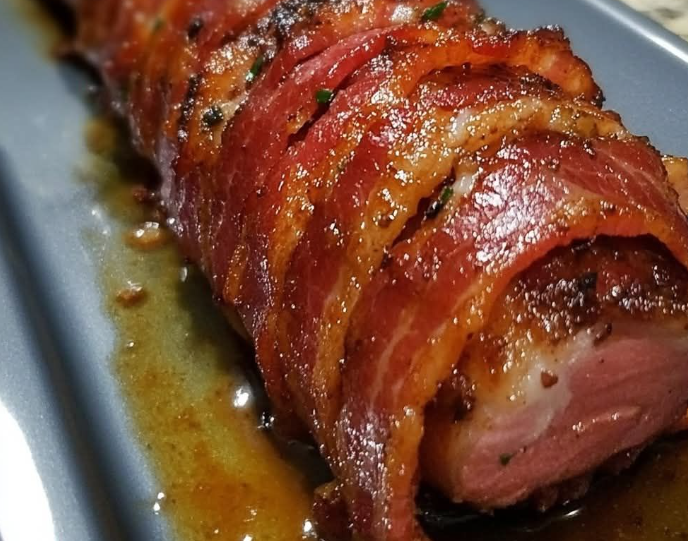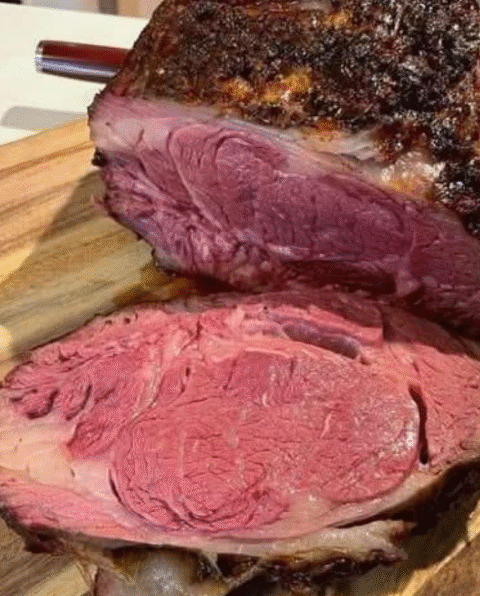Brown Sugar Bacon Wrapped Pork Tenderloin – A Sweet and Smoky Delight
Comfort food lovers, gather ’round! There’s something undeniably satisfying about combining the smoky, savory flavor of bacon with the sweet caramelization of brown sugar. In this recipe, Chef Bobby Flay shows us how to take everyday ingredients like pork tenderloin, bacon, and spices and turn them into a show-stopping centerpiece. Whether you’re cooking for family, guests, or simply cravin’ something utterly delicious, this recipe is here to deliver.
We’ll break it down step-by-step, include expert advice, health tips, and even a nutrition table. Plus, you’ll get 10 FAQs to cover all your cooking curveballs. Let’s get started! 🍽️
Why You’ll Love This Dish
- Sweet meets savory: Brown sugar caramelizes beautifully around bacon, creating a flavor contrast that’s irresistible.
- Perfect texture: Crisped bacon on the outside, juicy pork on the inside.
- Impressive yet easy: Looks gourmet but comes together with simple steps.
- Flexible sides: Pairs with veggies, salad, or even grains—makes great leftovers too.
Ingredients You’ll Need
Here’s everything you’ll want on hand:
- 1 (2 lb) pork tenderloin — trimmed of silver skin
- 10–12 slices of bacon — thin or regular cut (your preference)
- ⅓ cup brown sugar — packed
- 1 tablespoon smoked paprika — adds smoky depth
- 1 teaspoon garlic powder — or freshly minced garlic if you like
- ½ teaspoon salt
- ½ teaspoon black pepper
- 2 tablespoons olive oil — or other high smoke-point oil
Directions: Step-by-Step Instructions
- Preheat your oven to 400°F (200°C).
- In a small bowl, whisk together:
- Brown sugar
- Smoked paprika
- Garlic powder
- Salt
- Black pepper
- Lay the bacon slices on a flat surface, slightly overlapping. Sprinkle **half** of the brown sugar mixture evenly over the bacon.
- Place the pork tenderloin at one end of the bacon layout. Roll it up carefully, using the bacon to completely encase the pork. Tuck the ends to secure everything.
- Heat olive oil in an ovenproof skillet over medium-high heat. Once hot, sear the bacon‑wrapped tenderloin on all sides until golden brown (about 2–3 minutes per side).
- After searing, sprinkle the **remaining** brown sugar mixture over the top of the tenderloin.
- Transfer the skillet to the oven. Roast for about 20–25 minutes, or until the internal temperature reaches **145°F (63°C)** in the thickest part, measured with a meat thermometer.
- Remove from oven and let rest for **10 minutes** before slicing. This resting time lets juices redistribute so the pork stays moist.
- Slice and serve. Make sure each slice has the caramelized bacon wrap. Serve alongside roasted vegetables, mashed potatoes, or a fresh salad.
Expert Tips from Chef Gordon Ramsay & Ina Garten 👩🍳👨🍳
- Choosing your pork: Go for a tenderloin of even thickness so it cooks evenly. If one end is thinner, fold it under or tie with kitchen twine.
- Bacon selection matters: A thin‑sliced bacon crisps up more quickly; thicker slices give more chew. Adjust sear/roast as needed.
- Caramelization control: After applying brown sugar, be watchful during sear—sugars burn easily. Moderate heat or shorter sear if needed.
- Resting is key: Rest for at least 10 minutes uncovered or loosely tented with foil. Cutting too soon loses juices.
- Thermometer tips: Use an instant‑read digital thermometer. 145°F means medium‑rare to medium, but if you like a bit more doneness, 150–155°F is okay (carryover will finish it off).
Health Tips & Safety Considerations
This isn’t “health food,” but there are ways to make it a bit smarter while keeping it delicious:
- Trim visible fat from the pork tenderloin and use moderate amounts of bacon to reduce saturated fat content.
- Use nitrate‐free or lower‐sodium bacon to cut back on preservatives and sodium load.
- Use smoked paprika instead of liquid smoke to avoid additives; smoked paprika also contributes antioxidants.
- Balance the richness with fiber: serve with nutrient‐dense sides like roasted Brussels sprouts, spinach, steamed broccoli, or a salad.
- Ensure food safety: always cook pork to safe internal temperature (145°F / 63°C) and avoid cross‑contamination in prep (cutting boards, utensils, hands).
- If you need to reduce sugar, you can cut brown sugar to ¼ cup and consider adding a spray of honey glaze halfway through roasting.
Nutrition & Health Benefits Table
| Nutrient | Amount per Serving* (approx.) | Health Benefit |
|---|---|---|
| Calories | ~400–500 kcal | Provides energy; good for active individuals. |
| Protein | ~35–40 g | Supports muscle repair, immune function. |
| Total Fat | ~25–30 g | Provides essential fatty acids; helps absorption of fat‑soluble vitamins. |
| Saturated Fat | ~9–12 g | Keep within dietary limits to support heart health. |
| Carbohydrates | ~15–20 g | From brown sugar; gives energy and sweetness. |
| Sugar (added) | ~12–15 g | Moderate consumption advised; helps with flavor balance. |
| Sodium | ~800–1000 mg** | Watch intake if monitoring blood pressure. |
| Iron, B Vitamins | Moderate amounts | Pork provides B12, zinc; paprika adds antioxidants. |
*Based on dividing the dish into 4 servings. Figures are estimates.
**Depending on bacon brand and salt used.
Serving Suggestions & Variations
- Serve with roasted root vegetables (carrots, parsnips, potatoes) to soak up the bacon juices.
- Fresh green salad with a vinaigrette helps cut the richness.
- Grain‑based side: quinoa, brown rice, or wild rice with herbs complements the flavors.
- For extra flavor: glaze with balsamic reduction or maple syrup during last 5 minutes of roasting.
- Swap seasonings: add a bit of cayenne for heat, or rosemary/thyme for herbal notes.
Inside the Science: What Makes It Work
Knowing the why helps you replicate success every time:
- Caramelization: Brown sugar under high heat (searing + roasting) triggers the Maillard reaction plus sugar browning. That gives rich, complex flavor and crust.
- Bacon fat: Melts and bastes the pork, keeping it moist. Also adds flavor through fat‑soluble compounds.
- Resting: Allows carryover cooking and redistribution of juices so slices stay juicy.
- Even cooking: Encasing in bacon, searing, then roasting helps get good crust while ensuring internal temperature is safe.
Possible Dietary Adjustments
- Lower sugar / sugar‑free: Replace some or all brown sugar with monk fruit sweetener or erythritol; test for caramelization behavior.
- Less pork, more plant: Slice pork thinner or combine with grilled vegetables for a mixed plate.
- Lower sodium: Use low‑sodium bacon and reduce added salt.
- Pork alternatives: Try this method with turkey tenderloin or chicken breast, adjusting cooking time accordingly.
Related Recipes & Pairings
- Garlic Herb Roasted Vegetables – to serve alongside, adds color and fiber.
- Spiced Apple Sauce – sweet‑tangy contrast to the bacon and pork.
- Simple Arugula Salad – bitter greens help balance richness.
- Herb Garlic Mashed Potatoes – creamy and comforting side dish.
Frequently Asked Questions (FAQs)
1. How do I know when the pork tenderloin is done?
Use a digital instant‐read thermometer. Pork is safe at 145°F (63°C) in the thickest part. After removing from oven, rest for 10 minutes—internal temperature will rise slightly (“carryover cooking”).
2. Can I prepare this ahead of time?
Yes! You can wrap the pork in bacon and season it the night before. Keep it refrigerated. When ready, sear and roast just before serving. Brown sugar might darken, so handle carefully during searing.
3. What if I don’t have smoked paprika?
Regular paprika works too (though less smoky). You could also substitute a bit of liquid smoke or chipotle powder—but start small (½ teaspoon) to avoid overpowering the flavor.
4. Is there a good way to reduce calories without sacrificing flavor?
Yes. Use turkey bacon or a leaner bacon alternative. Reduce brown sugar. Pair with lighter sides like steamed greens instead of starchy sides. Trim pork well.
5. Can I cook this on a grill instead of in the oven?
You certainly can! After searing (or directly placing bacon‐wrapped tenderloin over indirect heat), move to a grill set to medium heat (~375–400°F). Cook until internal temperature reaches 145°F, likely 20‑30 minutes, turning occasionally.
6. What sides go best with this dish?
Great pairings include roasted vegetables (e.g. Brussels sprouts, carrots, asparagus), mashed potatoes, rice pilaf, or a crisp salad to lighten the overall meal.
7. How do I get the bacon extra crispy?
After roasting, you can broil for 1‑2 minutes keeping a close eye to avoid burning. Alternatively, after sear, let bacon hang slightly off a rack in the skillet so fat drains and bacon crisp‑exposed. Use thinner bacon slices too.
8. What variations can I try with the flavor profile?
You can add herbs like rosemary, thyme or sage; swap smoked paprika for chipotle or ancho chili; include a glaze of maple syrup or balsamic near end; or add citrus zest for brightness.
9. How to store leftovers, and how long will they keep?
Allow tenderloin to cool, then wrap tightly. Keeps in refrigerator for 3‑4 days. To reheat, use oven at 325°F (160°C) until warmed through, or microwave with a lid to retain moisture. Freeze for up to 2 months; thaw in refrigerator overnight.
10. If I have dietary restrictions (low sugar, low sodium), what adjustments can I make?
You can reduce added sugar, use sugar substitutes, use low‑sodium bacon, reduce salt, or choose leaner meat. Also, accompany with high fiber, low‑salt sides to balance the meal.
Final Thoughts
This Brown Sugar Bacon Wrapped Pork Tenderloin combines indulgence with technique. Under Chef Bobby Flay’s guidance (and borrowing tips from Gordon Ramsay & Ina Garten), you get a beautifully balanced dish—sweet, smoky, savory, and tender. It’s “wow‑worthy” enough for a dinner party, yet simple enough for a weeknight treat.
Cooking is as much about love and experience as it is about technique. Don’t stress perfection: timing, searing, resting—all build up flavor and texture. And as you experiment with sides, seasonings, and dietary tweaks, you’ll find your signature version.
Enjoy the process—and enjoy every succulent, caramelized bite! 😋






